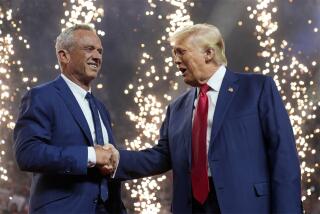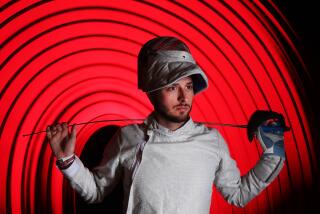A Free Spirit, on the Luge : Santa Cruz’s Kennedy Gives U.S. a Shot at Gold Medal
- Share via
The best luger in America has a tattoo on his left biceps, a Bart Simpson sticker on his sled and visions of a gold medal.
He first sat on a borrowed luge at 12 and has survived a brain lesion, worked as a go-fer for ABC during the 1980 Winter Games, worn his hair long, cut it short, burned out at 22, been revived at 23 and is now so good at the sport he is nicknamed “Speed.”
At 24, Duncan Kennedy seems poised for stardom of some sort. He could become the first American to win a medal in luge since the sport was added to the Olympic repertoire in 1964. Or he might decide to scale the Alps in flip-flops.
In any event, Kennedy looks like a sure thing to become the first Dread Zeppelin fan/snowboarding-surfing-skateboarding devotee from Santa Cruz to make an impact in the Winter Olympics. Kennedy might not win a gold medal, even though he is one of the favorites, but he is already certain to represent a fresh breeze blowing across the French Alps.
Americans have long been outsiders in this sport, which is dominated by the Austrians and Germans, but Kennedy acts as if he belongs. He finished the World Cup circuit ranked second behind Markus Prock of Austria, whose points edge over Kennedy was only 165-164. Kennedy’s World Cup finish was the highest standing ever by an American and included two golds, two silvers and a bronze medal in the first five World Cup races of the season.
“We’re catching up,” Kennedy told Olympian magazine. “We may be there. They’re looking at us, definitely.”
You could forgive his fellow competitors if they were looking at Kennedy’s tattoo instead. Last summer, Kennedy saw a skateboarding sticker he liked so much that he adapted it for his biceps. The words U.S. luge are written on a circle of stars and stripes with a red contrail of fire coming out the bottom, working its way down toward his elbow.
Born in Burlingame, Calif., Kennedy’s family moved to Lake Placid, N.Y., when he was 11. A year later, he ran errands and delivered newspapers for ABC-TV during the 1980 Olympics. Kennedy spent the money he earned on his first sled.
Then, at 13, Kennedy won his first of three national junior titles and a year later gained America’s first international medal in men’s luge with a second in the Junior Grosser Preis race in Igls, Austria. He qualified for the U.S. senior national team in 1985, two weeks after his 17th birthday.
Kennedy was stricken with an unexplained paralysis that affected one of his eyes in 1981. Doctors found a brain lesion; his mother was told Kennedy had only a year or two to live. Kennedy’s luge days were over. But four months later, a CAT scan revealed the lesion in his brain stem had disappeared. Kennedy got back on his sled.
He made the U.S. Olympic team at Calgary, which was notable chiefly for the controversy he created when he managed to upset the luge team’s major sponsor on the eve of the Games. Kennedy objected to the use of 3M-made aerodynamic riblet tape on the bottoms of the sleds.
For Kennedy and the U.S. men, it was tough sledding at Calgary. He finished 14th and decided to try competitive snowboarding.
But he returned to luge last year, giving up snowboarding for one very good reason: “I was getting my butt kicked.”
There is every reason to believe Kennedy can win a luge medal. At the 1991 World Championships, which marked his return to luge from snowboarding, Kennedy finished seventh, the highest level by an American male in Olympic or World Championship competition. Then he finished fourth in a test run at La Plagne, France.
More to Read
Go beyond the scoreboard
Get the latest on L.A.'s teams in the daily Sports Report newsletter.
You may occasionally receive promotional content from the Los Angeles Times.






